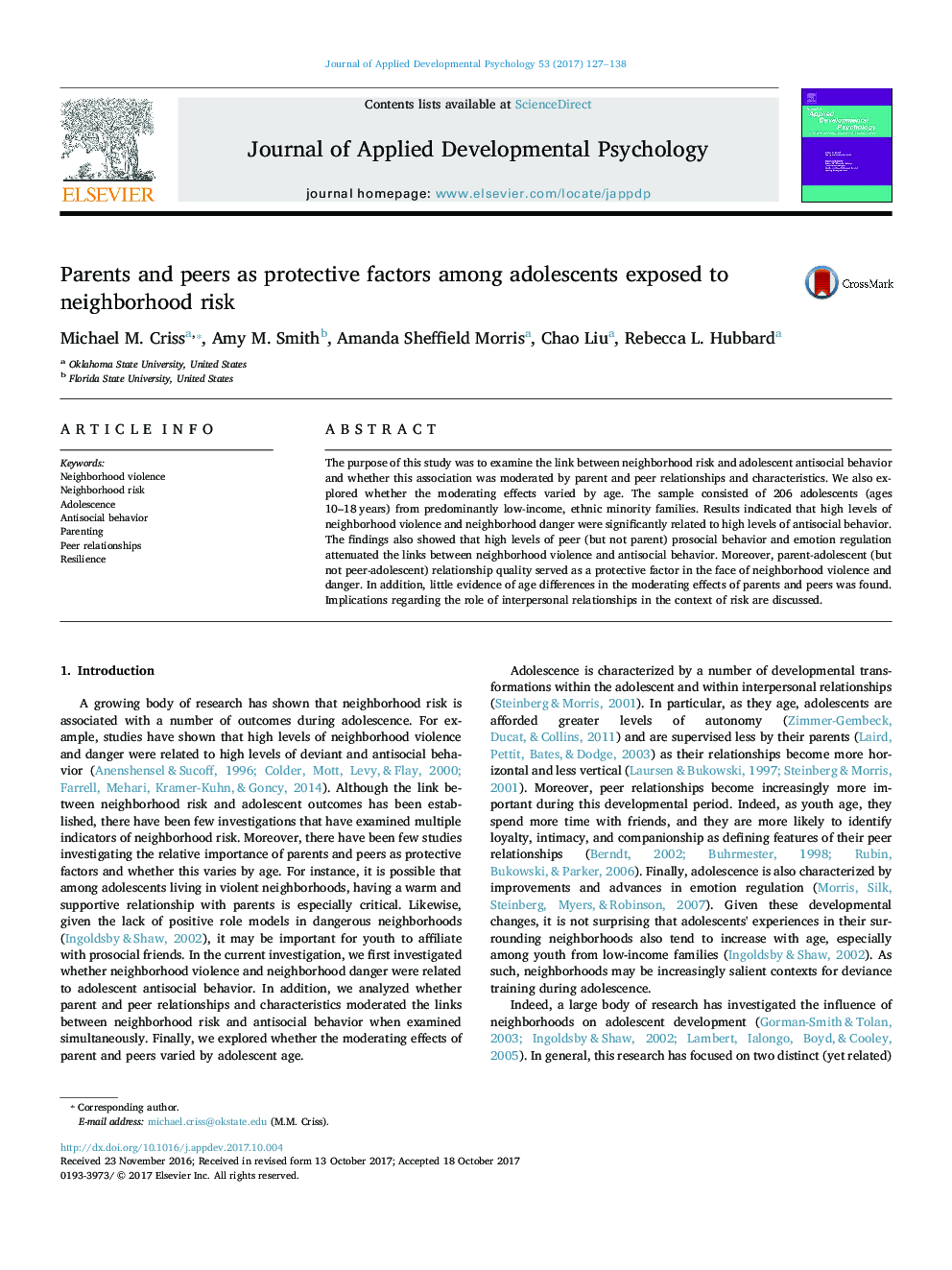| کد مقاله | کد نشریه | سال انتشار | مقاله انگلیسی | نسخه تمام متن |
|---|---|---|---|---|
| 6842826 | 1435935 | 2017 | 12 صفحه PDF | دانلود رایگان |
عنوان انگلیسی مقاله ISI
Parents and peers as protective factors among adolescents exposed to neighborhood risk
ترجمه فارسی عنوان
والدین و همسالان به عنوان عوامل محافظت در میان نوجوانان در معرض خطر محله
دانلود مقاله + سفارش ترجمه
دانلود مقاله ISI انگلیسی
رایگان برای ایرانیان
کلمات کلیدی
خشونت همسایه، خطر محاصره، بلوغ، رفتار ضد اجتماعی، والدین، روابط همسالان، انعطاف پذیری،
ترجمه چکیده
هدف از این مطالعه، بررسی ارتباط بین خطر محله و رفتار ضد اجتماعی عاطفی است و این ارتباط را با روابط و خصوصیات والدین و همسالان تعدیل می کند. ما همچنین بررسی کردیم که آیا اثرات تعدیل شده از نظر سن متفاوت است یا خیر. نمونه شامل 206 نوجوان (در سن 10-18 سالگی) از خانواده های دارای اقلیت قومی با درآمد پایین و پایین بود. نتایج نشان داد که سطح بالاتری از خشونت محله و خطر محیط به طور معناداری با سطوح بالای رفتارهای ضد اجتماعی مواجه است. یافته ها همچنین نشان داد که سطح بالایی از رفتارهای انضباطی (و نه والد) رفتار عاطفی و تنظیم احساسات، ارتباط بین خشونت محله و رفتار ضد اجتماعی را کاهش می دهد. علاوه بر این، میزان ارتباط والدین و نوجوانان (اما نه همسالان و نوجوانی) به عنوان عامل محافظتی در برابر خشونت و خطر محله در کنار هم قرار گرفته است. علاوه بر این، شواهد کمی از تفاوت های سن در اثرات تعدیل کننده والدین و همسالان مشاهده شد. مفاهیم مربوط به نقش روابط بین فردی در زمینه ریسک مورد بحث قرار گرفته است.
موضوعات مرتبط
علوم انسانی و اجتماعی
روانشناسی
روان شناسی کاربردی
چکیده انگلیسی
The purpose of this study was to examine the link between neighborhood risk and adolescent antisocial behavior and whether this association was moderated by parent and peer relationships and characteristics. We also explored whether the moderating effects varied by age. The sample consisted of 206 adolescents (ages 10-18Â years) from predominantly low-income, ethnic minority families. Results indicated that high levels of neighborhood violence and neighborhood danger were significantly related to high levels of antisocial behavior. The findings also showed that high levels of peer (but not parent) prosocial behavior and emotion regulation attenuated the links between neighborhood violence and antisocial behavior. Moreover, parent-adolescent (but not peer-adolescent) relationship quality served as a protective factor in the face of neighborhood violence and danger. In addition, little evidence of age differences in the moderating effects of parents and peers was found. Implications regarding the role of interpersonal relationships in the context of risk are discussed.
ناشر
Database: Elsevier - ScienceDirect (ساینس دایرکت)
Journal: Journal of Applied Developmental Psychology - Volume 53, November 2017, Pages 127-138
Journal: Journal of Applied Developmental Psychology - Volume 53, November 2017, Pages 127-138
نویسندگان
Michael M. Criss, Amy M. Smith, Amanda Sheffield Morris, Chao Liu, Rebecca L. Hubbard,
